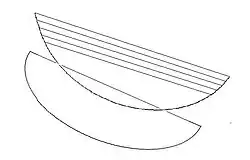 Line drawing of a Kafir harp. | |
| String instrument | |
|---|---|
| Other names | waj, waji, vaj, vaji |
| Classification | chordophone |
| Hornbostel–Sachs classification |
|
| Related instruments | |
| ennanga | |
The Kafir harp (known in the local language as waj, waji, vaj or vaji) is a traditional four- or five-stringed arched harp used by the Nuristanis native to the Nuristan Province of northeastern Afghanistan and Lower Chitral District of northwestern Pakistan. It is played during social gatherings, and to accompany epic storytelling or songs of heroic tales.[1]
Similar harps used to be widespread in ancient times throughout Central Asia and India,[2] and this harp possibly entered Afghanistan during the spread of Buddhism across the region[3] but today the waji is not used in any other part of Afghanistan.[4] It has been compared to the ennanga of Uganda and harp designs used in Sumer and ancient Egypt as far back as 3000 BC.[5]
Construction and design
The Kafir harp is constructed of two main components, the soundbox and the stringholder. The soundbox is made from a hollowed piece of wood with a thick piece of animal skin stretched over it.[6] The stringholder is a curved branch that sits on top of the soundbox,[6] and up to five strings are pulled through holes created along the side of the branch. On one side of the branch, the strings are held in place with non-tuning knobs, on the other side the strings dangle off the instrument like tassels. One harp collected in an anthropological expedition in the 1950s had four strings that corresponded to the central tetrachord of the Dorian mode.
Playing technique
When one plays the Kafir harp one has to balance the sound box on the left arm, leaving the strings to face up, rather than away from the musician. It is played with a plectrum in the right hand while using the left hand to mute certain strings. Stylistically, a piece of music featuring the Kafir harp may begin with an ostinato figure on the harp, underneath a soloist (who may or may not be the Kafir player himself) and/or by syncopated hand-clapping.[4]
Cultural importance
The Nuristanis, who claim a lineage back to Alexander the Great's Macedonian armies and who converted to Islam in the late 19th century, inhabit a remote mountain area in the north-east. The instruments played in Nuristan tend to be unique to the region, and there are no similar types of zithers or harps like the kafir harp to be found in other parts of Afghanistan.[4] This harp is played predominantly by men in the region.
References
- ↑ Klimburg, Max (2004). "The Arts of Societies of the Kafirs of the Hindu Kush". Journal of the Royal Society for Asian Affairs. Academic Search Premier EBSCO. 35 (3). doi:10.1080/0306837042000241046.
- ↑ Slobin, mark (2010). "Central Asian Arts: Music". Universalium. Retrieved 2011-10-03.
- ↑ Ferdinand J. de Hen (2001). Instruments de musique indiens. Edition trilingue français-néerlandais-anglais. Editions Mardaga. pp. 4–. ISBN 9782870097908. Retrieved 5 February 2011.
- 1 2 3 Baily, John. "Afghanistan: II. Regional Styles, 5. Other minority groups". Grove Music Online. Oxford Music Online. Retrieved 2011-10-03.
- ↑ Tehuti Research Foundation. "Egyptian Musical Instruments" (PDF). Archived from the original (PDF) on 2004-09-27. Retrieved 2011-09-27.
- 1 2 Alvad, Thomas (1954). "The Kafir Harp". Man. Royal Anthropological Institute of Great Britain and Ireland. 54 (233): 151–154. JSTOR 2795578.